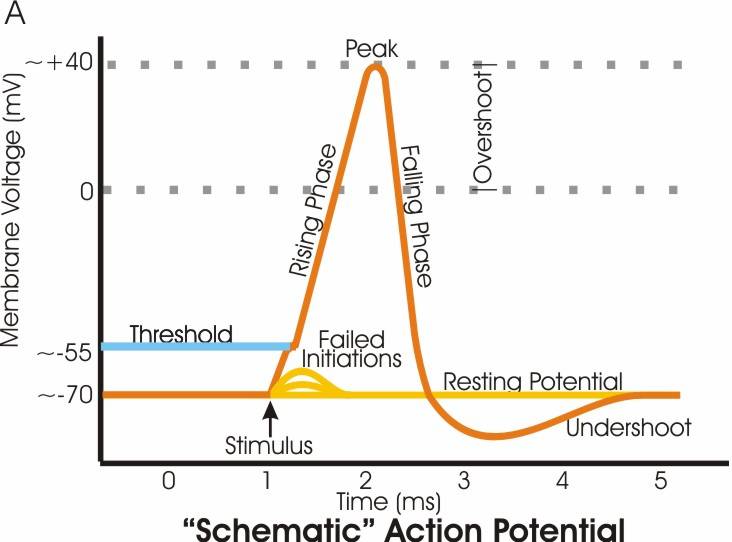Hyperpolarization (biology)
Editor-In-Chief: C. Michael Gibson, M.S., M.D. [1]
Hyperpolarization is any change in a cell's membrane potential that makes it more polarized. That is, hyperpolarization is an increase in the absolute value of a cell's membrane potential. Thus, any change of membrane voltage in which the membrane potential moves farther from zero, in either a positive or negative direction, is a hyperpolarization.
Examples

1. During the undershoot period after an action potential, the membrane potential is more negative than when the cell is in the "resting state". In the figure to the right, this undershoot is from approximately 3 to 4 milliseconds (ms) on the graph. The undershoot is the time when the membrane potential is hyperpolarized relative to the resting potential.
2. During the rising phase of an action potential, the membrane potential changes from negative to positive. In the figure, the rising phase is from approximately 1 to 2 milliseconds on the graph. During the rising phase, once the membrane potential becomes positive, the membrane potential continues to hyperpolarize until the peak of the action potential is reached at about +40 millivolts.
In both examples 1 and 2 (above), the hyperpolarization of a biological cell means an increase in the trans-membrane voltage; the membrane charge is more polarized. Thus, hyperpolarizations can be changes in membrane potential that are either in the positive or the negative direction.
In the scientific vernacular however, "hyperpolarization" (and its opposite, "depolarization") are sometimes used in a different way than described above. See the article depolarization for its technical definition and how it is used in descriptions of membrane potential changes. See the next section (below) for hyperpolarization.
Vernacular usage
For the description of action potentials, "hyperpolarization" has taken on an informal, technically incorrect meaning. In this scientific vernacular, hyperpolarization is often used to describe a change in membrane potential that makes it more negative (less positive). However, during the falling phase of the action potential (approximately from 2 to 3 milliseconds in the figure) the membrane potential first becomes less positive after the peak of the action potential and approaches zero. Membrane potential changes from +40 to 0 are technically depolarization of the membrane, not hyperpolarization. Despite it being technically incorrect, text books[1] sometimes use "hyperpolarization" to describe membrane potential changes in the direction from positive to negative such as the entire falling phase of the action potential.
References
- ↑ An example of how a textbook uses "hyperpolarization" in a technically incorrect way: "Opening of K+ channels as the action potential reaches its peak permits efflux of K+ ions, which initially hyperpolarizes the membrane." From the online 4th edition of the Molecular Cell Biology textbook by Harvey Lodish, Arnold Berk, S. Lawrence Zipursky, Paul Matsudaira, David Baltimore, James E. Darnell. New York: W. H. Freeman & Co.; c1999.
See also
External links
- Neuroscience - online textbook by Purves, et al
- Basic Neurochemistry Molecular, Cellular, and Medical Aspects by Siegel, et al